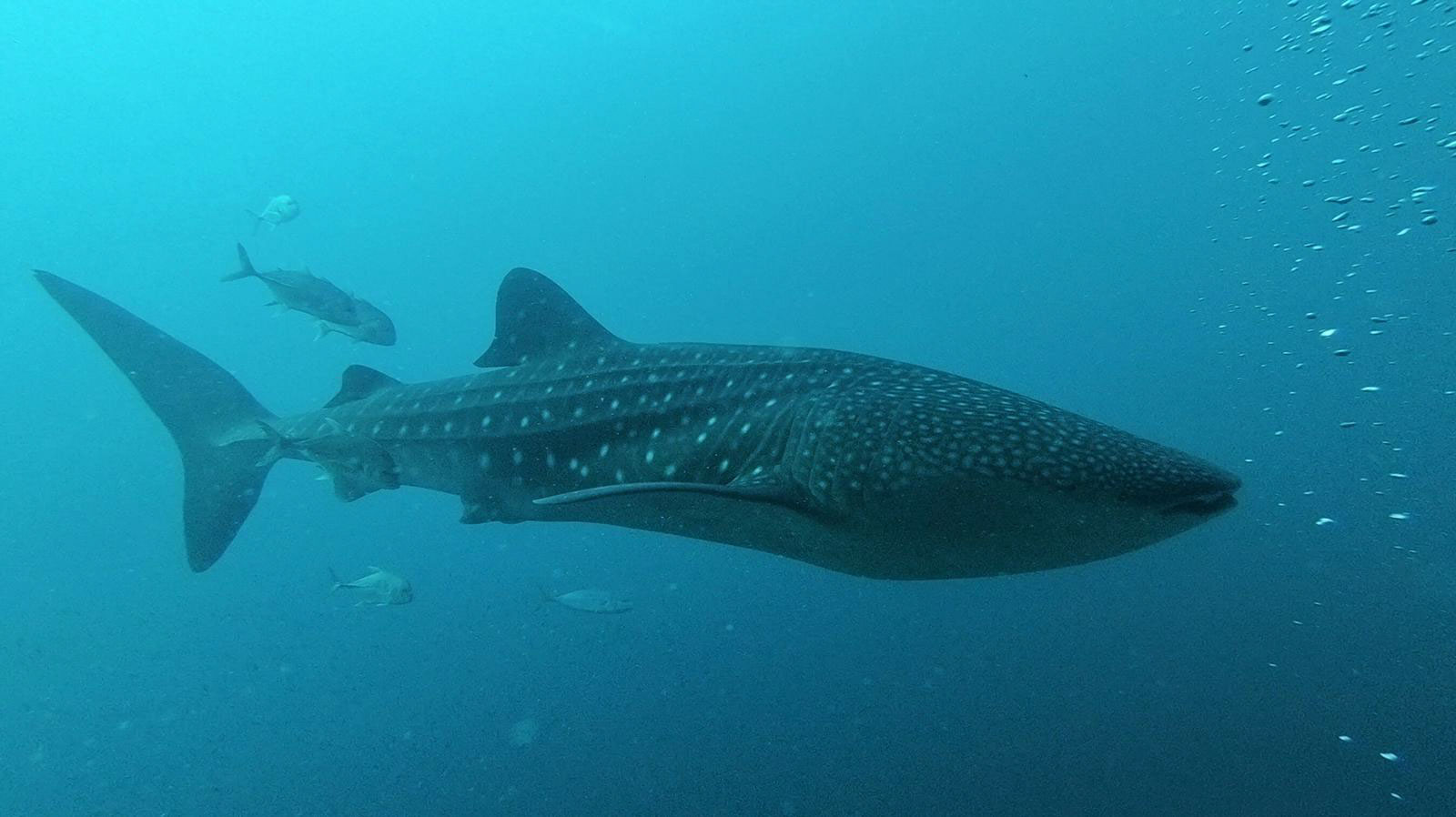
Divers usually love sharks, and for good reason. These wonderful fish have survived for millions of years as apex predators of the seas & oceans. But many people who don’t dive believe that sharks are dangerous. Mankind’s fear of the unknown is natural, especially when in an alien environment. The famous movie Jaws certainly didn’t help sharks’ reputation, either. And the few incidents involving sharks and humans each year are blown out of proportion. The truth is that most species of shark will not intentionally have anything to do with a human, especially scuba divers. This is especially true for the handful of different species of sharks in Thailand.
Most of the information about sharks biting people is a myth, and the reports are sensationalised. The facts are not as exciting to read, because worldwide incidents between sharks and humans are so rare. Mankind is much more of a threat to sharks than sharks are to us.
We are certainly not on sharks’ list of prey, as we are far too bony and we lack the nutrients that they require. The reason some sharks may bite humans is usually in error. Shark eyesight is not one of their main senses. But they have an excellent sense of smell, plus a sixth sense that detects the electrical pulses given off by all living creatures. So it’s easy for them to misidentify a swimmer or surfer for something that they do eat. When they check – by biting, because they don’t have hands – they realise their error and swim away. Surfers laying on their surfboards are most vulnerable, because when viewed from below their silhouette can look just like that of a turtle or a seal. Any shark that would misidentify a surfer for a large turtle or a seal will normally swim quickly up to the surface to strike in ambush. Because if a seal knows that there is a shark nearby, it can easily escape. The shark needs the element of surprise. A few times a year, surfers around the world are victims of shark bites which are wrongly called 'atttacks.' In some cases, extreme blood loss can prove fatal.
As for spear fishermen, their activity will actually attract sharks in two ways. The first way is the blood that a speared fish will cause to leak into the sea. We all know how well sharks can detect blood in water. The second way is that many species of sharks are particularly good at detecting injured or stressed fish. The vibrations in the water made by a struggling fish cause a frequency that is different from healthy swimming fish.
Sharks do not bite scuba divers, and this is for several reasons. Mainly because a diver spends most of the time at depth and is not a silhouette on the surface. Divers are also often covered in neoprene, plastic and a large metal tank. Therefore the shark can easily see that the diver is not food. The only exception is scuba divers who are spear fishing, which has already been discussed.
In many cases a shark is quite near a group of scuba divers and it will just swim away before anyone notices its presence. Some species are more shy and others relatively nonchalant. It’s important to remember that the sea is their home and divers are just visitors. They will always be aware of divers before the divers are aware of sharks. In Thailand, the three most-commonly seen species are the Whitetip Reef Shark (Triaenodon obesus), the Blacktip Reef Shark (Carcharhinus melanopterus) and the Zebra Shark (Stegostoma fasciatum). Whitetip Reef Sharks & Zebra Sharks are both nocturnal hunters, so they tend to sleep during the day. Whitetips will swim away before divers approach, but Zebra Sharks are much easier to get close to. Blacktips are very shy, and mostly seen in shallow water early in the morning or just before dusk.
Feeding sharks is a topic on which people have contrasting opinions. Some say that it raises awareness of the species while others claim that it’s wrong to encourage sharks to associate humans with food. In The Caribbean, Australia and South Africa divers can join tours where sharks are fed while humans are very near. This is sometimes on a sandy seabed or from a cage attached to the boat. These activities are not available in Thailand, anyway.
Different Types of Shark
Most people’s first thought of a shark is a large, fat animal with a mouth full of sharp teeth, but this is the minority. Just a few of the more than 300 species of shark are like this. Most are very small and eat crabs and similar crustaceans on the bottom of the sea, or filter plankton through their gills. But these species aren’t very interesting or exciting when telling a story or making a movie.
Sharks with lots of sharp teeth are the most feared and what most people think about when they hear the word shark, but in reality these kinds of shark are not very common. The Great White Shark (Carcharodon carcharias), Tiger Shark (Galeocerdo cuvier) and Bull Shark (Carcharhinus leucas) are the most notorious names, but also included in this group are the Oceanic Whitetip Shark (Carcharhinus longimanus), Mako Shark (Isurus oxyrinchus) & Blue Shark (Prionace glauca). Nearly all of these species are never reported in Thailand, but from time to time a Tiger Shrak or Bull Shark is spotted and sometimes caught on film.
Filter-feeding sharks include the Whale Shark (Rhincodon typus), the Basking Shark (Cetorhinus maximus) and the Megamouth Shark (Megachasma pelagios). But only the Whale Shark lives in Thailand. The Whale Shark is the Holy Grail for many scuba divers in Thailand, because it's the largest living species of fish.
Bottom-feeding sharks make up the vast majority of shark species. These include many species of fish that people don’t realise are sharks, and many are very small. In Thailand, the Leopard/Zebra Shark is many divers’ favourite, mainly because it is very docile and can seen by divers of all certification levels. However, Bamboo Sharks (Chiloscyllium griseum) & Guitar Sharks (Glaucostegus typus) are a couple of other species that spend much of their time on the seabed.
Sharks in Thailand
There are several species of sharks in Thailand. Some other sources may claim that the following list is too long (and the likes of Bull Sharks & Tiger Sharks are never seen in Thailand), and other sources may discuss some species that are not mentioned on this page. However, the list and information here was written after thorough research.
So which sharks can you find in Thailand?
| Name | What it looks like | Details | Feeding Habits | Seen At (click to open map) | Adult Size |
| Whale Shark |  |
On most divers’ bucket list | Plankton filter feeder | Richelieu Rock and Koh Tachai |
Up to 15 metres |
| Leopard/Zebra Shark |  |
Easiest to approach | Nocturnal bottom feeder | Koh Phi Phi and Phuket |
2 metres |
| Whitetip Reef Shark |  |
Normally seen deeper than 15 metres | Nocturnal Predator | Similan Islands |
1.6 metres |
| Blacktip Reef Shark |  |
Normally seen in very shallow water | Predator | Similan Islands |
1.6 metres |
| Guitar Shark | Normally seen deeper than 20 metres / Quite rare | Bottom feeder | Koh Bon |
2 metres | |
| Bamboo Shark | Very small, and hides during the day | Nocturnal bottom feeder | Similan Islands |
75 centimetres | |
| Nurse Shark |  |
Large, but harmless and docile | Nocturnal feeder | Similan Islands |
3 metres |
| Bull Shark |  |
Very rare in Thailand | Predator | Hin Daeng and Hin Muang |
3 metres |
| Tiger Shark | Very rare in Thailand | Predator | n/a | 4 metres |
The order of the list is the more popular and exciting species at the top, and the species which are less common last.
Whale Shark
(Rhincodon typus)
Diving with a Whale Shark is on almost every diver’s bucket list. This is not only the largest species of shark in the world, but of course the biggest of any extant fish species. Exactly how big they get is a contentious topic. However the general consensus is that they can grow as long as 15 metres in length. Whale Sharks in Thailand are usually 4-12 metres long, which is still huge. They are filter feeders, meaning that they swim slowly, sieving plankton. They are usually accompanied by several smaller fish that take advantage of the food, protection and slipstream. Some fish even attach themselves to Whale Sharks and get a free ride, too.
Seeing a Whale Shark would make any dive special. They can be seen at almost any depth, and often very near the surface, but always in open sea quite far from mainland. Of course, divers & snorkellers are naturally very excited, but if everyone stays relatively calm, the shark often hangs around. As long as it doesn’t feel threatened, it could stay with divers or near a boat for the rest of the dive. When diving at depth with an exciting species, it’s important to follow your NDL (No Decompression Limits) even though it's understandably difficult to say goodbye to these gentle giants.
Chumphon Pinnacle and Sail Rock in the Gulf of Thailand are good places to hope to see a Whale Shark in Thailand. Plus of course Richelieu Rock and Koh Tachai on the west coast / Andaman Sea.
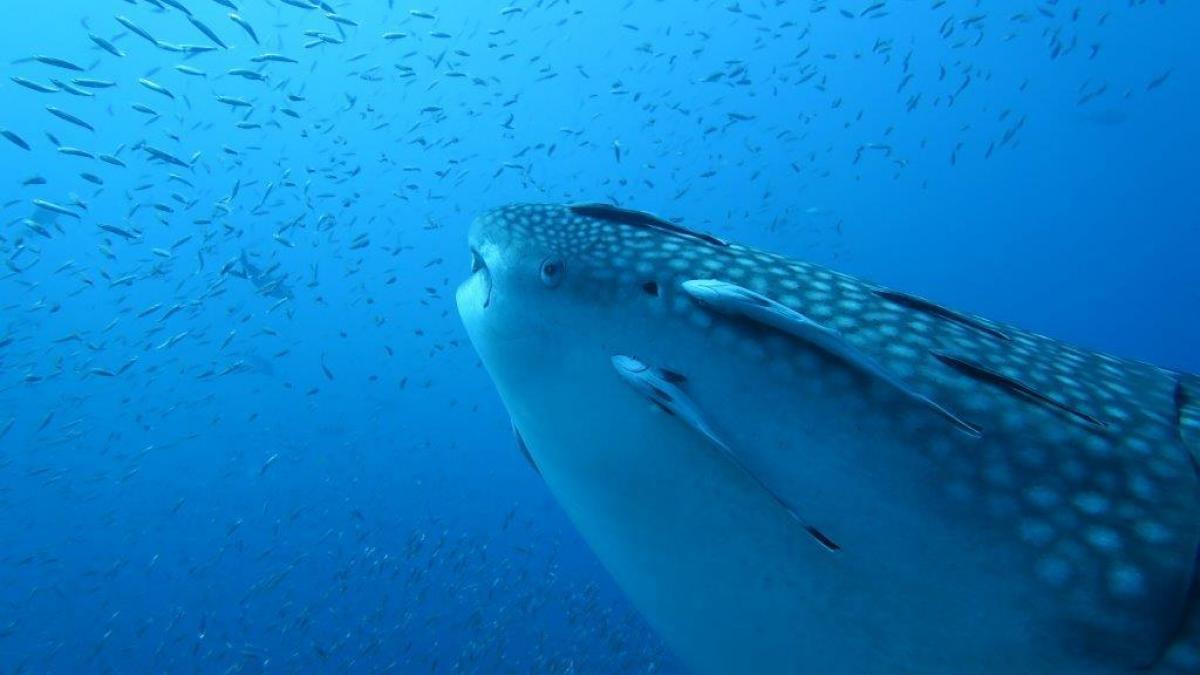 Whale Shark
Whale Shark
Leopard Shark
(Stegostoma fasciatum)
Actually, the proper common name is the Zebra Shark, due to the markings of the juveniles. But most divers refer to this species as the Leopard Shark. They used to be a lot more common in Thailand than they are now. It’s impossible to know if their numbers have decreased or they choose to spend more time away from dive sites. These sharks are nocturnal bottom feeders. Therefore, during the day they try to do as little as possible, and this means that they only swim away from divers if they feel uncomfortable. In general, if divers can keep their distance, the Leopard Shark will stay there on the seabed. They can grow to more than two metres in length but half of this is their very long tail. Although they spend the day on the seabed, this can be as shallow as 10 metres, depending on conditions. Therefore, they are often a ‘first shark’ for many divers. Since 2022 this species has become easier to find than before Covid. You're more likely to see one around Phuket or Phi than at the Similan Islands.
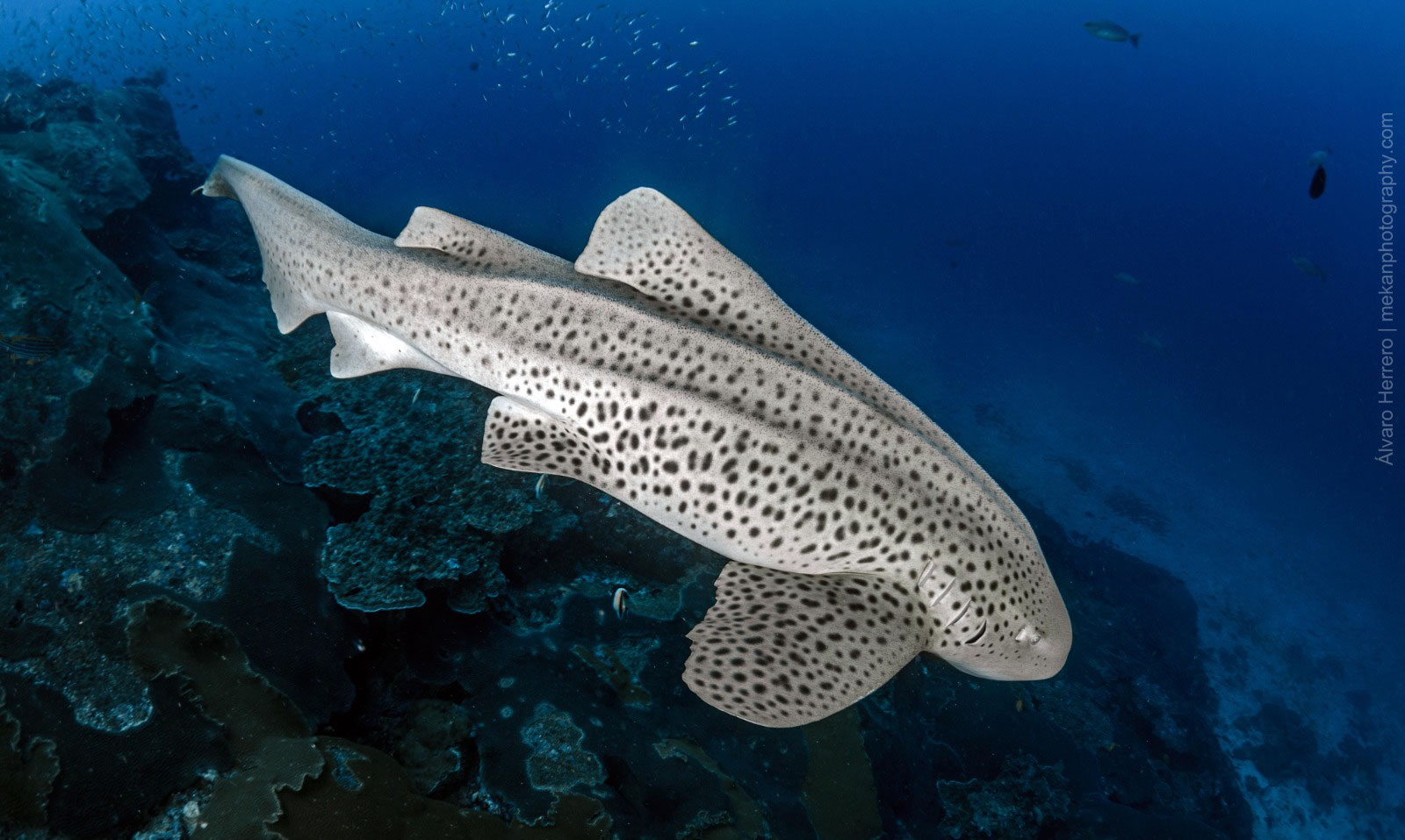 Leopard Shark
Leopard Shark
Whitetip Reef Shark
(Triaenodon obesus)
This is a ‘proper shark’ in many people’s eyes because of its shape and the fact it’s a fast-moving predator. The Whitetip Reef shark can grow to more than 1.5 metres in length and is quite slim. It usually feeds at night, often in groups. Therefore, during the day it’s possible to spot them resting under rocks or bommies. Divemaster guides and Instructors who have local experience can usually locate the resident Whitetips by looking in a few places where they often rest for the day. They can also be seen swimming in open water during the day, but they will keep their distance from divers, and swim away if followed. The Whitetip Reef Shark should not be confused with the Oceanic Whitetip Shark (Carcharhinus longimanus) which is not found in Thailand.
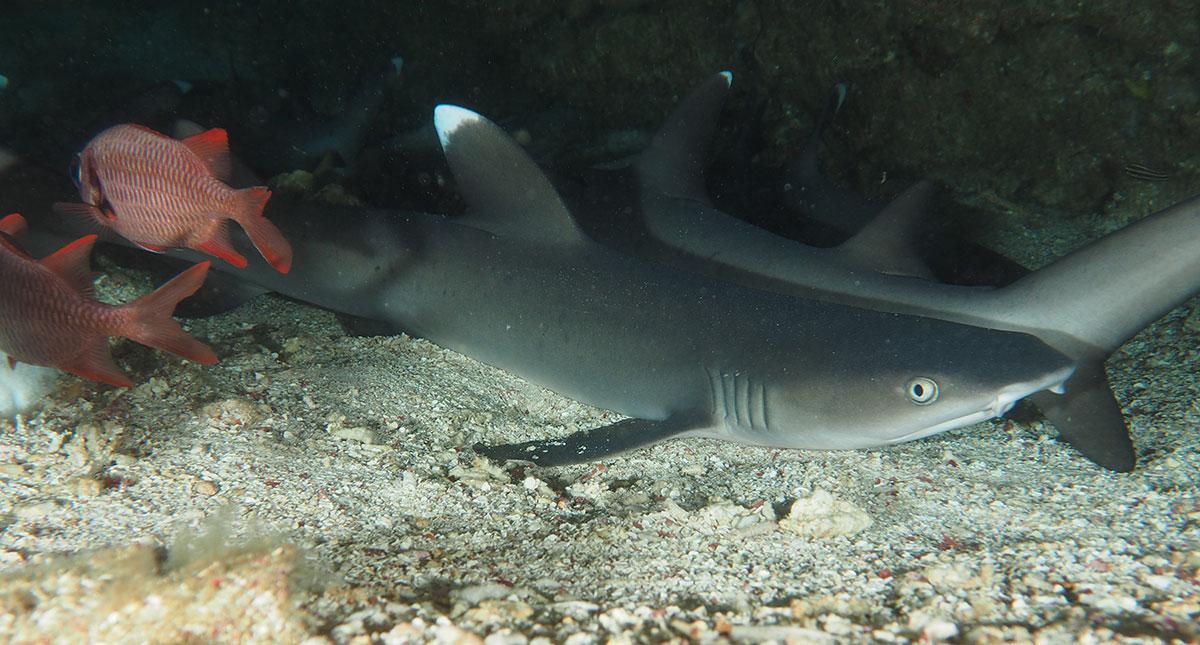 Whitetip reef sharks - Johan Folmeus
Whitetip reef sharks - Johan Folmeus
Blacktip Reef Shark
(Carcharhinus melanopterus)
This is a small but beautiful shark that has the shape of many larger species. It is a robust shape that suggests it’s an efficient hunter. The Blacktip Reef Shark grows to over 1.5 metres. It hunts mainly at dawn and dusk, and often in very shallow water. It can even be seen by patient snorkellers at depth of less than two metres. However, these are very shy sharks, and they nearly always keep their distance from humans and often swim away. Blacktip Reef Sharks should not be confused with Blacktip Sharks, which are larger but not found in Thailand. Black Tip Reef Shark numbers have recently increased around Koh Phi Phi's Maya Bay and Koh Bida Nok. These individuals are not shy of divers, and several can be seen at the same time.
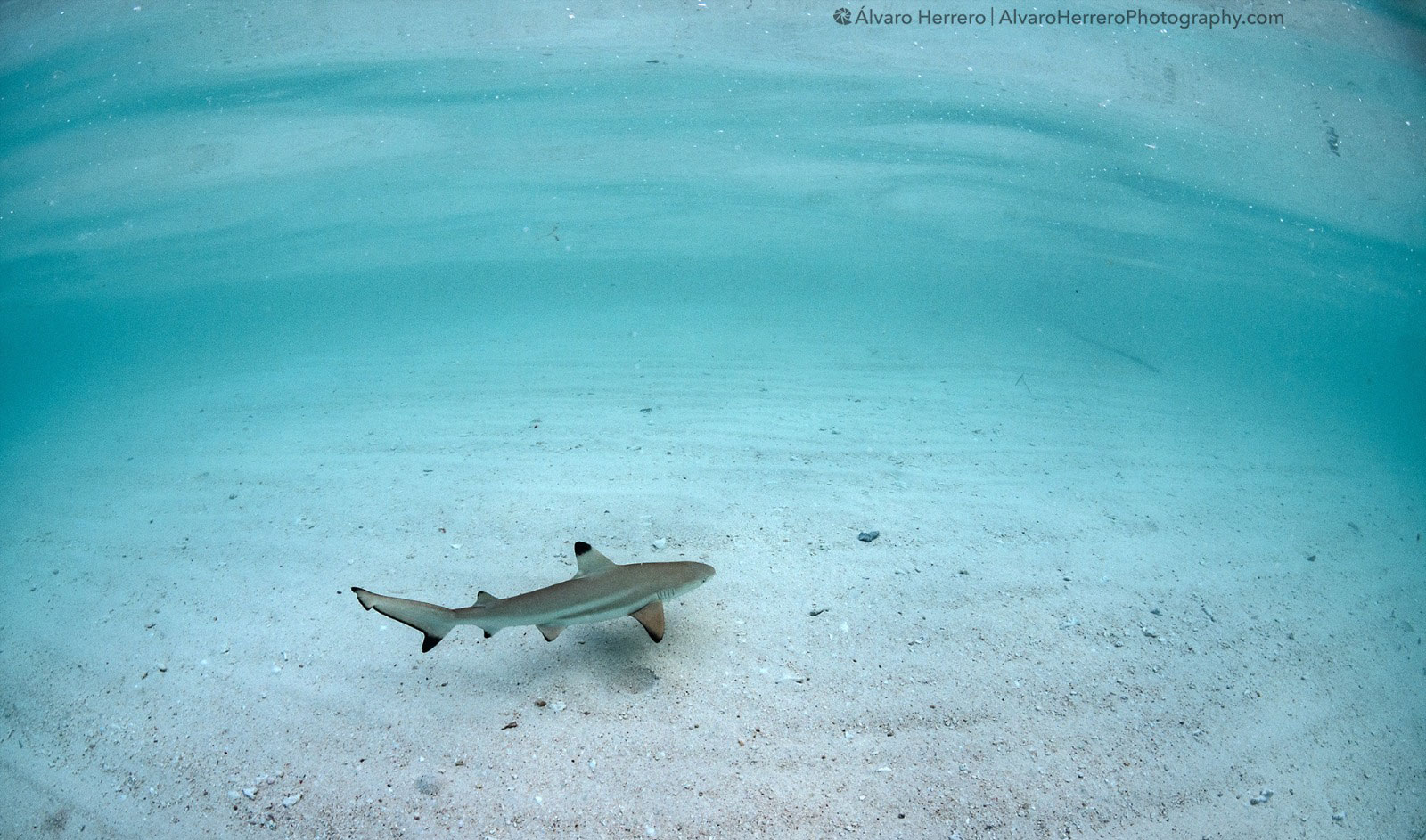 Blacktip Reef Shark
Blacktip Reef Shark
Guitar Shark
(Glaucostegus typus)
This is also referred to as the Shovelnose Ray by some people. Its names refer to its shape, which is similar to a guitar if viewed from above due to its large flat pectoral and pelvic fins. Plus it has a long flat snout. Guitar sharks are dark grey in colour and grow to more than two metres in length. The adults are more-commonly seen in deeper water, and quite shy. Their diet consists mainly of crabs and prawns. In late 2023 and early 2024 there were more sightings than normal of these sharks. It is believed that the cooler slightly murky water this season has encouraged species of sharks and rays that normally stay in deeper water to come within divers' depths.
Bamboo Shark
(Chiloscyllium griseum)
This is a small shark that grows up to 75cm in length, and is also known as the Carpet Shark & Cat Shark. Juveniles have some contrasting markings, but the adults are all brown. Their dorsal fins are equal in size, and smaller than their pelvic fins. They have barbels, like whiskers. Bamboo Sharks are nocturnal bottom feeders that eat invertebrates, such as crabs. Therefore, during the daytime, divers in Thailand can often find them resting under rocks, alone or in small groups. Divers normally only see parts of each shark, because they are small and can hide well.
Nurse Shark
(Nebrius ferrugineus)
The Nurse Shark gets its name from its ability to suck prey into its mouth like a nursing baby drinking milk. It is a large shark, growing to more than three metres in length. Normally it’s grey or brown all over, and its dorsal fin is quite far back on its body. It also has barbels around its mouth, used to locate prey in the sand. Nurse Sharks are commonly found in public aquariums, due to their size, docile nature and good survival in captivity. They are tolerant of divers, simply because they prefer to conserve energy during the day and their large size means that they rarely feel threatened by humans. However, like all marine life, divers must show them respect, and therefore not get too close. Like the Bamboo Shark, the Nurse Shark is usually a nocturnal hunter, feeding on crustaceans and cephalopods. During the day they often return to one of a few areas where they rest on the bottom, under a ledge or rock. In areas where they are abundant, sometimes six or more sharks rest together. However, in Thailand these sharks are no longer common, so they are normally only seen one at a time. They are usually seen deeper than 20 metres in The Gulf of Thailand and the west coast. For the best Nurse Shark experience, you should visit The Maldives on a liveaboard. Here it's easy to snorkel or dive with many Nurse Sharks.
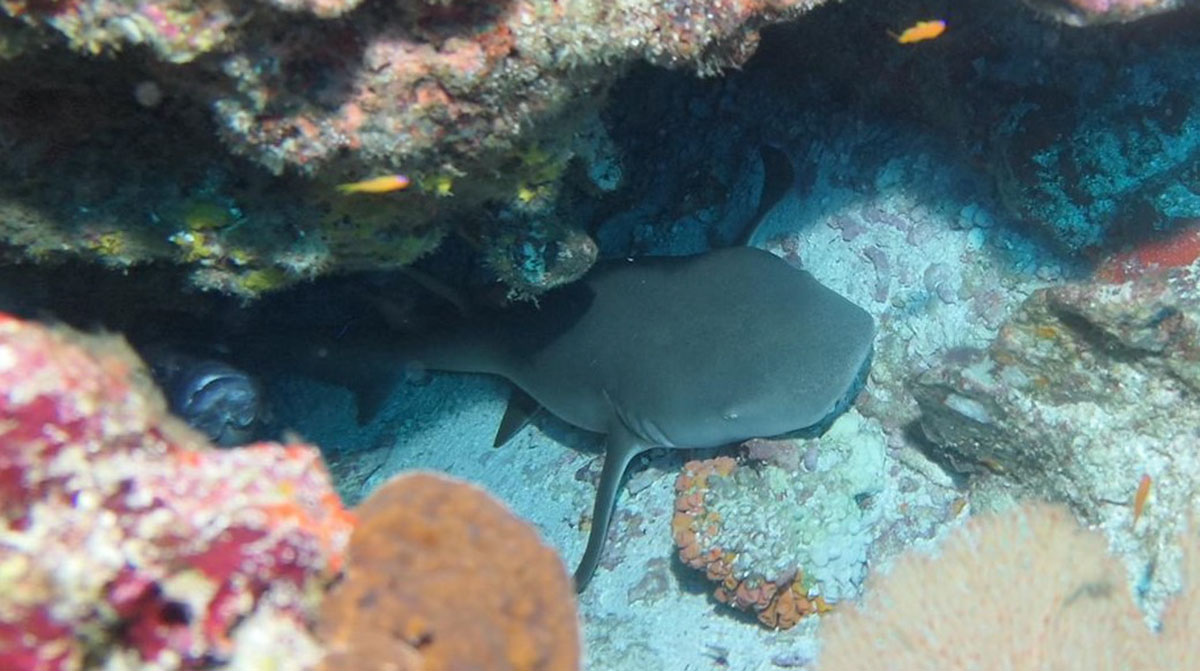 Nurse Shark
Nurse Shark
Bull Shark
(Carcharhinus leucas)
This species of shark is probably the most dangerous to humans. The reasons are mainly that they can survive in many more environments than other large and sometimes-dangerous species. In fact, they can even live happily in fresh water. Grey in colour, and growing up to around three metres in length, Bull Sharks have been known to attack humans in shallow waters of rivers and seas. They are probably responsible for many shark incidents that are blamed on other species. It’s very rare to see a Bull Shark in Thailand, but divers do claim to have done so. This is more often in The Gulf of Thailand, around Chumpon Pinnacle or Sail Rock. Sightings on the west coast are rare, but have been reported at Hin Daeng & Hin Muang. Due to their stealthy behaviour and colouration that makes them hard to see, it’s likely that misidentification is also possible in many cases. This means that divers who believe that they saw a Bull Shark actually saw another species. In January 2024 a group of up to seven Bull sharks were identified at Koh Bon, Similan Islands.
Tiger Shark
(Galeocerdo cuvier)
This is a large shark, growing up to more than four metres in length and having stripes on its sides which give it its name. Like the Bull Shark, the Tiger Shark is blamed for many incidences involving humans. Also, like the Bull Shark, it’s very rare for one to be seen in Thai waters, and even rarer for them to interact with people. The reason that this species is considered a potential danger is its size, its appetite, and its apparent lack of intelligence. There are many stories of items found inside the stomach of Tiger Sharks that are not its food. In 2021, at least one Tiger Shark was positively identified (with photos and video) at The Similan Islands. In 2023 and 2024 more individuals have been seen, including at the southern Similan Islands and Hin Muang.
Sharks and Humans
 It’s important to understand that humans are much more of a threat to sharks than sharks are to us. Plus, most of the time a shark is in the water and knows that humans are nearby, but it does nothing more than swim away unnoticed. We are not of interest to sharks, and not only do they have more and better senses than we do, they can also swim faster than us, and to any depth that they choose. Therefore, they are there but they tend to stay away. Many other animals (mostly mammals & reptiles on land) hurt or kill people but incidences are so common that they’re not reported. But a few times a year - worldwide - a shark may misidentify someone in its environment and make the mistake of biting, normally just to check. When that happens, it’s big news. And for scuba divers in Thailand, it’s unheard of for a shark to bite a diver. The several species that are found in Thailand are all welcomed by divers, especially the majestic Whale Shark, but also the smaller species. To get the best chance to dive with sharks in Thailand, join one of our Similan liveaboard diving cruises. Trip lengths are from overnight to a week or longer.
It’s important to understand that humans are much more of a threat to sharks than sharks are to us. Plus, most of the time a shark is in the water and knows that humans are nearby, but it does nothing more than swim away unnoticed. We are not of interest to sharks, and not only do they have more and better senses than we do, they can also swim faster than us, and to any depth that they choose. Therefore, they are there but they tend to stay away. Many other animals (mostly mammals & reptiles on land) hurt or kill people but incidences are so common that they’re not reported. But a few times a year - worldwide - a shark may misidentify someone in its environment and make the mistake of biting, normally just to check. When that happens, it’s big news. And for scuba divers in Thailand, it’s unheard of for a shark to bite a diver. The several species that are found in Thailand are all welcomed by divers, especially the majestic Whale Shark, but also the smaller species. To get the best chance to dive with sharks in Thailand, join one of our Similan liveaboard diving cruises. Trip lengths are from overnight to a week or longer.


